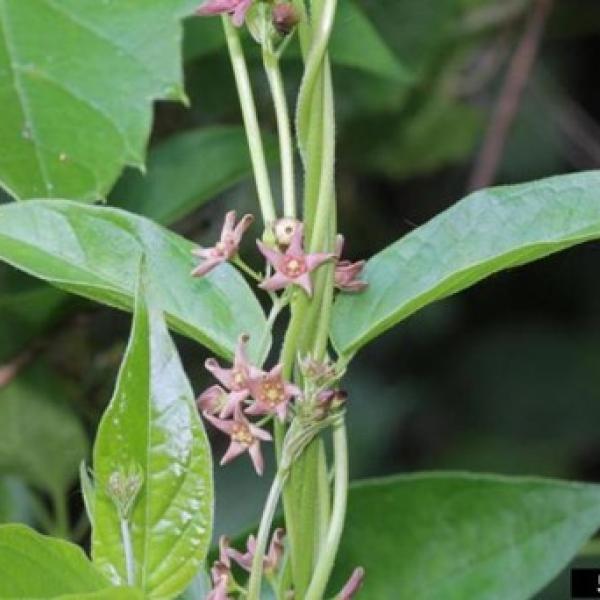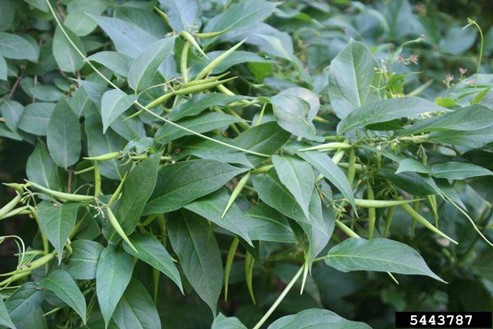
There are two species of non-native, invasive swallowwort known in Vermont, pale swallowwort (Vincetoxicum rossicum; syn. Cynanchum rossicum) and black swallowwort (Vincetoxicum nigrum; syn. Cynanchum louiseae). Both species are of particular concern because they form dense, extensive patches of vegetation that alter the chemical and physical structure of their habitat; they crowd out native plant species, release toxic compounds, and in so doing disrupt natural succession and reduce biodiversity. Swallowworts belong to the Apocynaceae or dogbane family, which includes periwinkles and milkweeds, in addition to almost 5000 other species of flowering plants. Members of this family have milky, often poisonous sap, and many are cultivated for their attractive foliage and flowers.
Pale swallowwort is native to the Ukraine and south-eastern European Russia and was originally imported in the early 1900s for ornamental interest. This species has several common names, including European swallowwort and dog-strangling vine. It was discovered for the first time in Vermont in 2023, and is listed by the Vermont Agency of Agriculture, Food and Markets as a Class A Noxious Weed which means it is considered to pose a serious threat to the state.
Although its known range in Vermont is limited to a number of sites in Chittenden County, it is widespread in southern Ontario, as well as the eastern United States from southern Maine to northern Maryland, with occurrences in the Great Lakes and Midwest, including New York State. It is suspected that pale swallowwort’s Vermont distribution is greater than currently known. If you believe you have found this species, you can verify your observations and report your findings on VTInvasives.org.
Identification
Stems: Pale swallowwort is an herbaceous, perennial vine that twines around itself and adjacent structures. Vines have clear, watery sap and commonly reach 1-2 m (3-6.5 ft) in length. Stems are covered in downy hairs, and dried stems can persist into fall and winter.
Leaves: Swallowworts have opposite, smooth leaves. They are shiny, dark green, narrowly oval, and have pointed tips. They are about 5-13 cm (2-5 in) long and 2-6.5 cm (1-2.5 in) wide.
Flowers: Pale Swallowwort flowers in early summer. They are star-shaped with five curled petals, ranging from light pink to burgundy in color. Flowers are in clusters of 6-10 and attach at the leaf bases.
Fruit/Seeds: Swallowworts develop smooth, slender, milkweed-like pod clusters that split when the seed is ripe. Seeds are on silky filaments that allow wind dispersal.
Similar Species
Milkweeds: The related native milkweeds such as swamp milkweed (Asclepias incarnata) and common milkweed (Asclepias syriaca) grow in sunny areas and can grow 3-5 feet tall. Although they have similar seedpods and opposite leaves, they stand upright and have milky sap, with much more elaborate flower clusters.
Dogbanes: The related native dogbanes such as spreading dogbane (Apocynum androsaemifolium) have narrow seedpods like swallowworts, but they are also upright, not twining vines. Their flowers are arranged at the stem tips, as opposed to the base of the leaves.
Dogwoods: Native dogwoods can be mistaken for swallowworts when they are very young, because their opposite leaves have a similar shape. However, they are woody and not herbaceous.
Key ID Features of Pale Swallowwort

Pale swallowwort intertwined on itself with seed pods present. Credit: Chris Evans, Illinois Wildlife Action Plan, Bugwood.org
- Vines twine around each other or adjacent structures, NOT upright standing.
- Opposite leaves, lance-shaped and shiny with smooth edges.
- Clear, watery sap.
- Small, light pink to purple star-shaped flowers in small clusters along the leaf bases.
Reproduction and Dispersal
Pale swallowwort emerges in spring and typically flowers in June. The flowers can self-pollinate, although sexual reproduction is more common. The plants produce seed pods from late June through early August, and wind dispersal of dried seeds occurs from late July into the fall. Although many seeds land within a few meters of the parent plant, some can be carried several hundred meters by gusts of wind.
Many pale swallowwort seeds are polyembryonic, which means that a single seed can contain two or more embryos, giving rise to multiple seedlings. In addition, plants in full sun produce more flowers, seedpods, and seeds, with seed densities of 32,000 seeds per square meter documented.
Swallowworts form associations with beneficial mycorrhizal fungi, which result in improved nutrient cycling. Root colonization rates are higher in swallowwort than in native species growing in the same area. Dense swallowwort vegetation exposes the seedling root systems to the mycorrhizal network, which in turn results in enhanced swallowwort nutrition at the expense of native plants.
Swallowworts are allelopathic; they produce and release toxic chemical compounds into the soil which suppress the growth of neighboring species. Extracts from their root systems cause reduction in growth of roots and shoots in associated native plant species such as common milkweed, which is critical for the survival of monarch butterflies.
Impacts
Aided by their highly successful mechanisms of seed dispersal, mycorrhizal associations, and allelopathic activity, swallowworts can densely colonize a variety of sites and form extensive patches of vegetation. Native herbivores such as deer tend to avoid swallowwort to feed on more palatable plant species, which further amplifies the patch growing tendency of this plant. Because of its tangling nature, large patches are difficult to travel through and can interfere not only with native plant regeneration, but also recreation and forest management activities.
Studies have looked at the potential effects of swallowwort on native biodiversity, including impacts on arthropod diversity and abundance, bird populations and soil microbial activities, rare and threatened plant species, and monarch butterfly reproduction. Monarchs don’t typically lay their eggs on swallowwort, but when they do the leaves are fatally toxic to the larvae. In addition, swallowwort aggressively outcompetes common milkweed, the preferred larval host of the monarch.
Management
Pale swallowwort is an early detection species in Vermont, because it is minimally established and therefore presents an opportunity for containment within its presently known range. Although eradication of this species may be difficult or impossible in Chittenden County locations where it is already infested, these sites are isolated and can be contained with vigilant reporting, monitoring, and control of this species. It is important to keep isolated plants or small infestations from expanding into large populations in which plant vigor and productivity are amplified. If you think you have observed Pale swallowwort in your area, report it to VTInvasives.org.
- Mechanical Control: In general, controlling swallowwort populations requires a multi-year effort. Mechanical control options such as hand pulling or digging may be effective in small infestations if the entire root crown can be removed. Removing seed pods from plants will minimize the number of additional seeds and slow reproduction rates.
- Chemical Control: Herbicides such as foliar sprays can be an effective measure for larger infestations, but always read and follow pesticide label directions. Application of pesticides may require a certification from the Agency of Agriculture, Food and Markets. The agency website provides applicator certification information.
- Biocontrol: In 2017, a species of leaf-eating moth was approved by the USDA as a biocontrol for pale swallowwort. It is still in experimental stages in New York State.